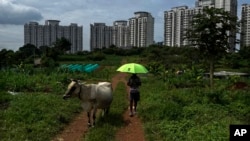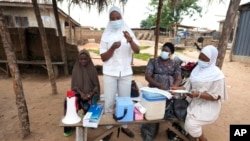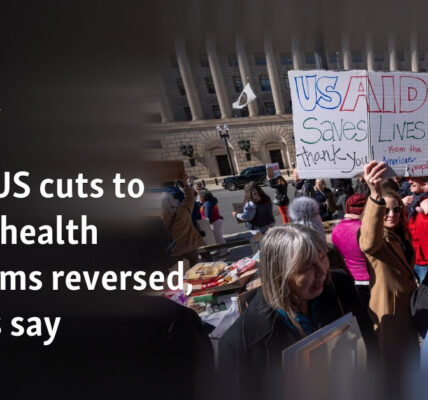The proliferation of dairy farms in India has resulted in a challenging issue of methane emissions.
BENGALURU, India —
Abinaya Tamilarasu stated that her four cows are considered as members of her family. She holds a degree in commerce from a nearby college, but she enjoys taking care of her cows and managing her family’s property at home.
“Our family cannot let farming go, it’s a way of life for us,” said the 28-year-old, who lives on her family farm in India’s southern Tamil Nadu state. Even when she could be making more money elsewhere, she said she’s “still happy we have our cows.”
India is the top producer of milk in the world, with an annual production of 231 million tons last year. It is also home to 80 million dairy farmers, including Tamilarasu, who typically only own a small number of cows. However, as a whole, the dairy industry in India has 303 million bovine cattle, including cows and buffaloes. This makes it the biggest contributor to the country’s methane emissions, which contribute to global warming. While the government has taken some steps to reduce these emissions, their focus is primarily on reducing emissions from other sources such as by transitioning to renewable energy. They argue that a large portion of methane emissions is unavoidable. However, experts argue that the industry can and should make more efforts to cut emissions in order to mitigate the effects of climate change.
Based on data from the International Energy Agency, India ranks as the third-highest emitter of methane globally. Livestock, primarily cattle, account for approximately 48% of methane emissions in India. This greenhouse gas has a strong impact on global warming, with the ability to trap over 80 times more heat in the atmosphere in the short term compared to carbon dioxide.
India has not made any commitments with other countries to reduce their methane emissions, which is considered to be a relatively easy way to combat climate change. Methane only stays in the atmosphere for about 12 years, while CO2 can persist for hundreds of years.
However, efforts are being made at the national level to decrease methane emissions in agriculture. The National Dairy Development Board, in collaboration with over 17 million farmers, is exploring ways to genetically improve the quality of feed for livestock. This would result in increased productivity of cows, allowing farmers to maintain the same milk production with fewer cows. Research conducted by the NDDB indicates that providing a balanced diet to animals can reduce emissions by up to 15%.
The board is also investigate lowering atmospheric emissions from crop burning, a common farming practice used to clear land, by feeding the crops to cows instead.
Meenesh Shah, the chairman of the board, stated that it is essential to pursue climate-smart practices in the dairy industry at this time.
According to Vineet Kumar of the Centre for Science and Environment in New Delhi, using high-quality feed can reduce emissions. He also suggested promoting indigenous breeds that produce fewer emissions. In his words, these approaches could benefit everyone involved.
However, veterinarian Thanammal Ravichandran, who is situated in Coimbatore, a city in southern India, pointed out that there is a lack of feed in the country. As a result, farmers are forced to provide their cattle with subpar and more environmentally harmful resources.
According to her, farmers face difficulties in investing in higher quality feed for their livestock. She believes that for dairy farmers to access more cost-effective feed, increased government assistance is necessary.
No matter what actions are implemented to decrease methane output, specialists suggest that it should have little effect on the way farmers make a living, and should consider the methods they use to raise their animals.
Kumar stated that livestock are an essential part of Indian agriculture and any major alterations to farming practices would greatly impact farmers. He also emphasized that efforts to decrease emissions should not lead to a decrease in the use of cow manure as a fertilizer on Indian farms, as chemical fertilizers produce nitrous oxide, a more potent greenhouse gas.
According to Bandish Patel, an energy analyst at the climate thinktank Ember, examining India’s overall methane emissions could reveal simple solutions for reducing the gas. Patel suggests that targeting the energy sector would be a straightforward way to decrease methane emissions.
He stated that emissions in agriculture are spread out, but in the production of oil, gas, and coal, there are specific sources that can be targeted for reducing methane in the future.
Shah from the NDDB emphasized that it is important to acknowledge India’s significant agricultural emissions, particularly due to its status as the world’s top producer of milk, the largest exporter of rice, and home to the largest cattle population, which contribute to methane emissions.
Shah stated that it is important to acknowledge the relatively low emissions from India’s agriculture sector. Due to its high population, India’s per capita emissions are below the average.
Tamilarasu, a dairy farmer, appreciates improvements in cow welfare and programs to promote better farming practices. However, she does not plan on giving up dairy farming due to climate change in the near future. She intends to continue her work for the foreseeable future.
According to her, the relationship between our cows and ourselves is mutually beneficial. By improving their well-being, we also improve our own.
Source: voanews.com




